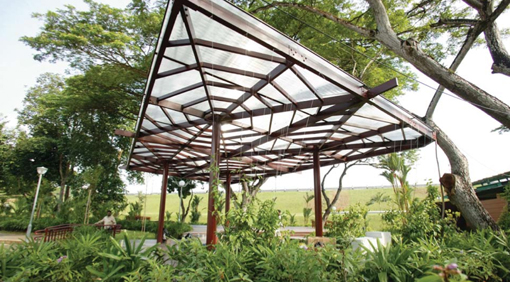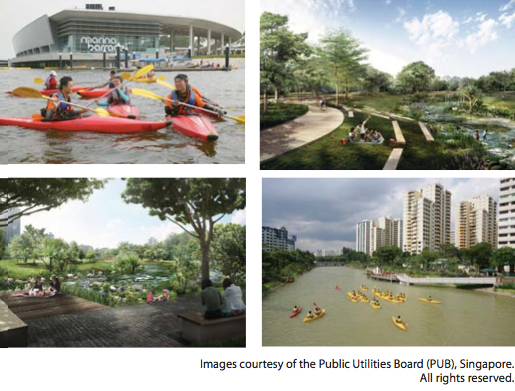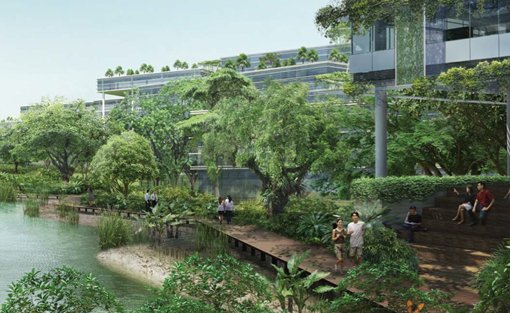
Singapore depends upon natural gas, imported through pipelines from Malaysia and Indonesia, for 80 percent of electricity generation. No surprise then that the issue of energy security has always been high up the agenda! The early years of the city state were marked by a series of challenges including water shortages, flooding and pollution, and so the water issue is also a high priority. Water policy, energy efficiency and the development of renewable energy resources are all critical components of a broad based integrated Master Plan for economic development, which ensures that Singapore can achieve ongoing sustainable growth. The development of appropriate clean technologies is considered as crucial, alongside technological and practical support for planning and design.
Large-grade "living laboratory"
Clean technology solutions are being promoted through Singapore's CleanTech Park (CTP). The park, which was launched by JTC Corporation and the Singapore Economic Development Board (EDB), in February 2010, will serve as a large-scale integrated "living laboratory" for the test-bedding and demonstration of system level clean technology solutions. CTP is an ambitious 20-year project comprising three phases. On completion in 2030, it is expected to have a working population of 20,000.
CTP will ultimately focus on a wide range of clean technology solutions, but in the meantime, much work is already under way in the city. In terms of renewable energy, Singapore is focusing heavily on the potential for solar photovoltaic power. There is ample sunlight in the region, but the deployment of solar energy has traditionally been restricted by a combination of available space and available technology (since most photovoltaic technology has been developed with temperate environments in mind). The Solar Energy Research Institute of Singapore (SERIS), within the National University of Singapore (NUS), is developing appropriate technology for tropical environments. SERIS is also focusing heavily on building integrated photovoltaic (BIPV) technology, which offers scope to generate solar power from the roofs and façades of buildings.
SERIS already works alongside industry players such as Phoenix Solar Pte Ltd and Grenzone Pte Ltd, on programmes to roll out solar photovoltaic systems in the city. Government departments such as the Energy Market Authority (EMA) and Building and Construction Authority (BCA) are playing an important role in facilitating such projects.
Smart grid technology key role to play
In terms of energy efficiency, Singapore has identified smart grid technology as having an important role to play. The city already has a high quality power grid with many smart features in place, including two-way communication systems at higher voltage levels and online condition monitoring systems to detect incipient faults. However, a truly smart grid will enable better decisions to be made about energy usage and will enhance efficiency in the power system as a whole.

The EMA has conducted a trial in two local housing estates, Marine Parade and West Coast, to evaluate a basic system of smart meters and time differentiated electricity tariff s. As part of this trial, households were provided with real time information on their electricity usage. The smart meters were demonstrated to result in a 2% reduction in electricity consumption, and when differential tariffs were introduced there was a 10% shift of the usual electrical load from peak to off-peak periods. Building on this success, the EMA will be rolling out a larger-scale pilot for smart grid applications with 4000 smart meters all over Singapore.
Test-bedding of EVs and charging infrastructure
Alongside the smart grid pilot, the city is looking at test-bedding electric vehicles and developing electric vehicle charging infrastructure. The EV test-bedding programme was launched by EMA and the Land Transport Authority (LTA) in 2009. The programme aims to formulate a viable model for e-mobility, developing systems solutions encompassing variables such as billing, managing the fl eet and the backend systems. A number of ministries and statutory boards, including the Agency for Science, Technology and Research (A*STAR), the Economic Development Board (EDB), and the National Environment Agency (NEA) are also involved.
The EV test-bedding programme is a typical example of cooperation on a key initiative between Singapore Government Agencies in what Dr Liu Thai Ker, Chairman of the Centre for Liveable Cities (CLC), describes as a "collaborative alignment" approach. The CLC is a policy oriented centre established by the Singapore Ministry of National Development and the Ministry of the Environment and Water Resources. From a policy perspective, Dr Liu argues that a top down approach is essential for a sustainable city. In the case of Singapore, according to Dr Liu, a holistic system has been adopted. The Singapore Government takes the lead in city planning; afterwards individual projects/professionals take over.
Dr Liu regards good planning as key to the creation of a sustainable city. His view is that good planning ensures "sustainable development with no extra cost"--and is to be preferred over reliance upon iconic green buildings as "proof"' of sustainability. Dr Liu describes Singapore's Master Plan 2008 as having adopted a specific approach to sustainability, incorporating: a compact city with transit-oriented development at core, strategic decentralisation and an integral leisure plan.
The Four National Taps
Planning was the key to resolving Singapore's water challenge through a long-term water supply strategy known as the Four National Taps. The "taps" are: Water from local catchment areas; imported water; recycled water; and desalinated water. Ultra-clean, high-grade recycled water, branded NEWater, was introduced in 2003 and marked a new era in Singapore's water history. Produced using state-of-the-art membrane technologies involving micro filtration, reverse osmosis and ultraviolet disinfection, it is supplied primarily for non-domestic use in wafer fabrication parks, industrial estates and commercial buildings, where it is used for industrial and air-cooling purposes. Meanwhile, Singapore's SingSpring desalination plant, one of the largest in the world and operational since 2005, produces 136,000 cubic metres of water per day, enough to supply around 10% of Singapore's needs.
In terms of water from local catchment areas, the Marina Barrage project, completed in 2008, created a reservoir in the heart of the city. The barrage also acts as a tidal barrier to alleviate flooding in low-lying areas and is a lifestyle destination in itself, offering an array of recreational activities, both on land and in water. Interestingly, the Marina Barrage has a Green Roof and it incorporates one of the largest solar energy parks in operation in Singapore.
Lack of land area rules out landfill as a viable means of treating municipal and industrial waste in Singapore and over 56 percent of the city's waste is already recycled. Waste management comes under the umbrella of the National Environment Agency (NEA), which aims to increase the recycling rate to 70 percent by 2030. There are four waste-to-energy (WtE) incineration plants in the city, which processed around 2.45 million tonnes of waste and generated some 1.05 million MWh of electricity in 2008. Singapore's WtE plants are designed and equipped with advanced flue gas treatment systems. Dust, particles and other pollution from incineration are managed by bag filters, gas scrubbers, and electrostatic precipitators.

Options for recycling the fly ash left after incineration as building materials are being researched by the NEA, but for now, most of it is taken to the Semakau Landfill. Semakau is an artificial island built between two atolls, 8km off the southern coast of the country. It is part of a larger project to design ways to use landfill (fly ash and construction material) on existing atolls, to construct a new island, and to regenerate mangrove and aquatic ecology.
Recycled materials for construction
The use of recycled materials for construction purposes is something of a theme in Singapore. The Building and Construction Authority (BCA) announced a $15 million to help construction industry-related companies to adopt sustainable construction practices and move towards self-sufficiency in construction materials in Singapore. The fund will focus on developing capabilities in recycling waste from demolished buildings and the use of recycled materials for construction.
Building sustainable cities is a global challenge and Singapore's expertise is being exported through the CLC. The CLC gathers together Singapore's expertise in urban management (high-density urban planning, land use, housing, transport, clean air and water management) and exchanges best practices with its counterparts around the world. International events like the Singapore International Energy Week (SIEW), Singapore International Water Week (SIWW) and World Cities Summit (WCS) also demonstrate Singapore's efforts to serve as a platform that goes beyond the island's shores.
The urbanisation challenge is particularly acute in Asia, where population density is high. Singapore is recognised as a reference city for sustainable development in Asia. Its expertise in eco-city design is being deployed through an innovative project in China: the Tianjin Eco-city, which is being jointly developed by the China Academy of Urban Planning and Design, the Tianjin Institute of Urban Planning and Design, and the Singapore planning team led by the Urban Redevelopment Authority.
Marrying energy efficiency and available resources
Through the efficient use of energy and the optimisation of available resources of land and water, Singapore's urban planners are successfully meeting the challenge of ensuring that five million people can live well in a relatively small area of 710km2. Singapore is a living demonstration of the truth that urbanisation, if combined with environmentally-friendly policies, does not necessarily damage the environment. Government policy is promoting the development of clean technologies appropriate for the urban environment--specifically the tropical urban environment--and creating a hub for innovation in the region. Singapore is one of the world's few truly 'sustainable' cities and is living proof that strong central planning can foster the development of new approaches to global challenges--as well as new technologies.
By : Dr Dennis Gross, Cleantech Magazine